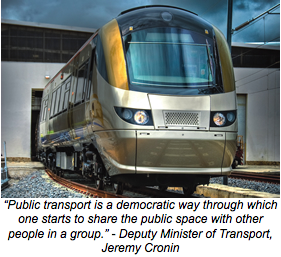Better transport for future generations
Better transport for future generations sadmin2010 World Cup legacy
Many South Africans and visiting football fans, had to use public transport during the FIFA World Cup. They were pleasantly surprised at how efficiently it worked. The country’s improved public transport system has been identified as one of the key legacy projects of the World Cup. This legacy will be enjoyed by generations of South Africans for many years to come.
Public transport formed the backbone of the transport plans for the 2010 FIFA World Cup. Government invested more than R40 billion to ensure a safe, efficient and reliable public transport system for this event.
The investment in public transport infrastructure has been identified as the most important legacy project of the Football World Cup.
Eye-opener
Deputy Minister of Transport, Jeremy Cronin, said the mass use of public transport during the football tournament had been an eye-opener for many. An important element in ensuring the success of the World Cup, was the use of public transport to reduce congestion on the roads and assist fans to arrive in good time for games, he said.
Some problems arose on the first day of the World Cup when many motorists didn’t observe calls to use public transport. This caused traffic jams around the stadium. But after that people acted on government’s calls and traffic flowed smoothly at the other matches and the closing ceremony.
Commitment
Cronin said Government’s commitment to improve public transport had seen a five-fold increase in the budget for transport infrastructure during the past several years.
“This is a start, but we need to build on it. Firstly, there has to be a change of attitude and this past World Cup showed that we can do it,” he said.
Improvements include world-class airports, upgraded railway stations, luxury buses and integrated rapid public transport networks such as the bus rapid transit system.
Host cities
All the host cities had World Cup transport plans with a public transport focus. These were supported by park-and-ride sys2010 World Cup legacytems, as well as park-and-walks. Fans were encouraged to plan their trips to the stadiums, fan parks and public viewing areas well in advance. Integrated Rapid Public Transport Networks such as the Johannesburg Rea Vaya Bus Rapid Transit (BRT) system were in operation and were popular with commuters.
Taxis
Government will continue to invest in public transport infrastructure initiatives to help the minibus taxi industry to transform itself, says Cronin. These initiatives include possible subsidies for minibus taxi operators. The Rea Vaya BRT in Johannesburg is already operated by taxi associations which employed former taxi drivers as bus drivers for the BRT buses.
